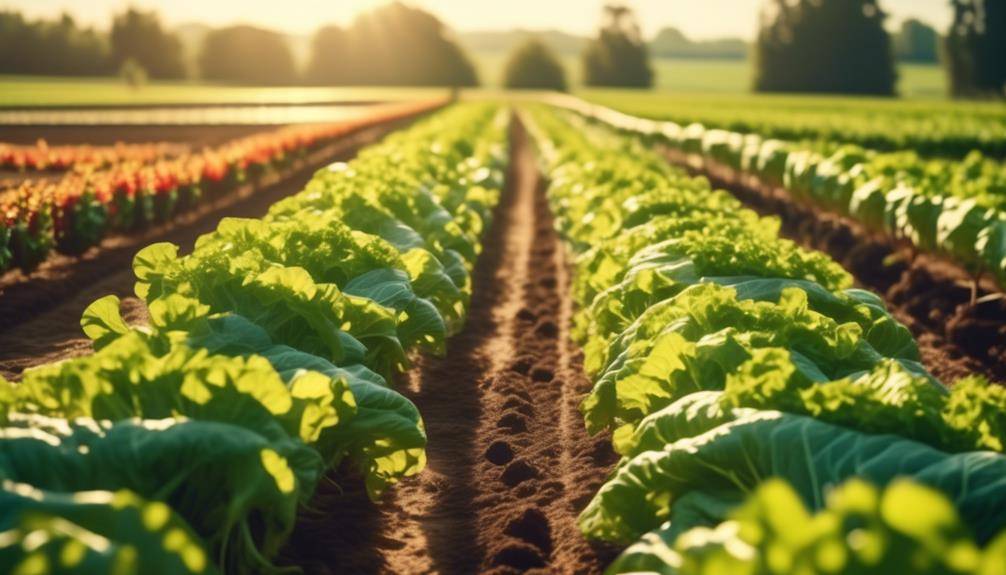Amazing Sustainable Farming Technologies For Organic Produce

Sustainable Farming Technologies; Are you looking for ways to enhance your organic farming practices while ensuring sustainability? Look no further. In this discussion, we will explore a range of innovative technologies that can revolutionize the way you grow organic produce. From vertical farming and hydroponics to precision agriculture and natural pollination methods, these cutting-edge solutions have the potential to optimize yields, conserve resources, and minimize environmental impact. Get ready to discover how these sustainable farming technologies can take your organic farming to the next level, and stay tuned for some exciting insights that might just change the way you approach agriculture forever.
Vertical Farming
Vertical farming is a sustainable agricultural practice that utilizes advanced technologies to cultivate crops in vertically stacked layers, maximizing space efficiency and minimizing the environmental impact. This innovative technique is revolutionizing the way we approach farming, particularly in urban areas where space is limited. By utilizing vertical farming techniques, sustainable urban agriculture becomes a viable solution to the increasing demand for fresh produce in densely populated cities.
One of the primary advantages of vertical farming is its ability to maximize space efficiency. Traditional farming methods require large expanses of land, which are often unavailable in urban environments. However, vertical farming allows crops to be grown in vertically stacked layers, utilizing the vertical space effectively. This means that a significantly higher number of crops can be grown in a smaller footprint, allowing for a higher yield per square meter of land.
In addition to space efficiency, vertical farming also minimizes the environmental impact associated with traditional agriculture. By growing crops indoors, vertical farming reduces the need for large-scale deforestation and the use of harmful pesticides. The controlled environment within vertical farming facilities allows for precise control over factors such as temperature, humidity, and lighting, creating optimal growing conditions for the crops. This reduces the need for chemical inputs, resulting in healthier and more sustainable produce.
Furthermore, vertical farming promotes sustainable urban agriculture by reducing the reliance on long-distance transportation of food. With vertical farms located within or near urban areas, the distance between farm and consumer is significantly reduced. This not only decreases the carbon footprint associated with transportation but also ensures that the produce reaches consumers at its peak freshness and nutritional value.
Hydroponics
Utilizing a soil-less cultivation technique, hydroponics revolutionizes traditional agriculture by providing a highly efficient and sustainable method of growing crops. Hydroponic farming, a subset of sustainable farming techniques, offers numerous advantages over conventional farming practices. Here are five key benefits of hydroponics:
- Water conservation: Hydroponics uses up to 90% less water compared to traditional farming methods. By recirculating and reusing the nutrient-rich water solution, hydroponics minimizes water waste and ensures optimal water usage.
- Nutrient control: In hydroponics, plants receive precise amounts of nutrients, eliminating the need for synthetic fertilizers and reducing the risk of nutrient runoff. This targeted approach promotes healthy plant growth and minimizes environmental impact.
- Space efficiency: Hydroponic systems can be set up in smaller areas, making them ideal for urban farming and maximizing land use. By growing plants vertically or in stacked layers, hydroponics allows for higher crop yields in limited spaces.
- Year-round cultivation: Unlike traditional farming, hydroponics enables year-round crop production by providing a controlled environment. This technology allows for the cultivation of seasonal crops throughout the year, increasing overall productivity and reducing dependence on imports.
- Reduced pesticide use: Hydroponic farming minimizes the need for pesticides, as plants are grown in a controlled environment that reduces the risk of pests and diseases. This not only ensures the production of healthier and safer crops but also contributes to a cleaner and more sustainable ecosystem.
Aquaponics
Aquaponics, a sustainable farming technology, offers numerous benefits and operates on a unique principle. By combining aquaculture and hydroponics, this innovative system creates a symbiotic relationship between fish and plants. The fish waste serves as a nutrient-rich fertilizer for the plants, while the plants purify the water for the fish. This closed-loop system maximizes resource utilization, minimizes water consumption, and eliminates the need for synthetic fertilizers, making aquaponics a promising solution for sustainable agriculture.
Benefits of Aquaponics
One of the most innovative and sustainable farming technologies available today is aquaponics, which combines the cultivation of fish and plants in a mutually beneficial system. Aquaponics offers several benefits that make it an attractive option for farmers looking to adopt innovative farming techniques:
- Efficient use of resources: Aquaponics uses 90% less water compared to traditional farming methods, making it a sustainable choice for water conservation.
- Organic produce: Aquaponics eliminates the need for synthetic fertilizers and pesticides, resulting in organic, chemical-free produce.
- Year-round production: With controlled environments, aquaponics allows for year-round production, reducing seasonal limitations and ensuring a consistent supply of fresh produce.
- Increased productivity: The symbiotic relationship between fish and plants in aquaponics creates optimal growing conditions, resulting in faster growth rates and higher yields.
- Diverse crop options: Aquaponics can support the growth of a wide range of crops, including leafy greens, herbs, fruits, and even flowers, providing farmers with diverse market opportunities.
Aquaponics presents a promising solution for sustainable agriculture, offering numerous benefits that contribute to a more efficient and environmentally friendly farming system.
How Aquaponics Works
Aquaponics functions as a dynamic, symbiotic system where fish waste is converted into nutrients for plant growth, creating a self-sustaining cycle of aquaculture and hydroponics. This innovative technique offers numerous benefits for sustainable farming. Firstly, it utilizes less water compared to traditional farming methods, as water is recirculated within the system rather than being continuously supplied.
Additionally, aquaponics eliminates the need for chemical fertilizers, pesticides, and herbicides, making it an environmentally friendly option for organic produce. The system also provides a controlled environment for plants, reducing the risk of pests and diseases. Moreover, aquaponics allows for year-round cultivation, maximizing crop yields and profitability. By harnessing the natural processes of fish waste conversion, aquaponics showcases how technology can revolutionize sustainable farming and pave the way for a greener future.
Precision Agriculture
Precision agriculture utilizes advanced technologies and data-driven approaches to optimize farming practices and maximize crop yield. It is a cutting-edge method that allows farmers to make informed decisions based on real-time data, resulting in more efficient and sustainable farming practices. This approach has gained popularity in recent years due to its potential to revolutionize the agriculture industry.
Here are five key components of precision agriculture:
- Remote sensing: Precision agriculture relies on remote sensing technologies such as drones, satellites, and aerial imagery. These tools provide farmers with valuable data on plant health, soil conditions, and crop growth, allowing them to identify areas that require attention and make targeted interventions.
- Data analytics: Precision agriculture uses advanced data analytics to process and analyze the vast amount of data collected from various sources. By applying algorithms and machine learning techniques, farmers can gain valuable insights and make data-driven decisions to optimize their farming practices.
- Variable rate technology: This technology enables farmers to apply fertilizers, pesticides, and irrigation water at variable rates based on the specific needs of different areas within a field. By tailoring inputs to the precise requirements of each zone, farmers can minimize waste and optimize resource allocation.
- Automated machinery: Precision agriculture incorporates the use of automated machinery, such as self-driving tractors and robotic equipment. These machines can perform tasks with unparalleled accuracy and efficiency, reducing labor costs and increasing productivity.
- Vertical farming: Precision agriculture has paved the way for vertical farming, a method that involves growing crops in vertically stacked layers. This approach maximizes land use efficiency and allows for year-round production, making it particularly suitable for urban areas with limited space.
Organic Fertilizers
Organic fertilizers offer a sustainable and environmentally-friendly alternative to synthetic fertilizers. They provide a range of benefits, including nutrient-rich compost that improves soil fertility, natural soil amendments that enhance nutrient availability, and plant-based fertilizers that promote healthy growth. By utilizing these organic fertilizers, farmers can optimize nutrient cycling, reduce chemical inputs, and support the long-term health and productivity of their soils.
Nutrient-Rich Compost
To maximize nutrient availability and promote sustainable farming practices, implementing nutrient-rich compost is an essential component of organic fertilizers. Nutrient-rich compost is derived from organic waste materials through various composting techniques. Here are five benefits of using nutrient-rich compost in organic farming:
- Increased soil fertility: Nutrient-rich compost adds essential nutrients to the soil, improving its fertility and promoting healthy plant growth.
- Enhanced soil structure: Compost helps improve soil structure by increasing its water-holding capacity and aeration, allowing roots to access nutrients more effectively.
- Weed suppression: Compost can act as a natural weed suppressant, reducing the need for synthetic herbicides and minimizing weed competition.
- Disease suppression: Certain composts contain beneficial microorganisms that help suppress soil-borne diseases, reducing the need for chemical interventions.
- Carbon sequestration: Composting organic waste diverts it from landfills, reducing greenhouse gas emissions and contributing to carbon sequestration in the soil.
Natural Soil Amendments
Implementing natural soil amendments, such as organic fertilizers, is crucial for enhancing soil quality and supporting sustainable farming practices. Organic amendments play a vital role in improving soil health by providing essential nutrients to the plants while promoting microbial activity and maintaining the overall balance of the ecosystem. These amendments, derived from natural sources like plant matter, animal manure, and compost, contribute to the long-term fertility and productivity of the soil. Unlike synthetic fertilizers, organic amendments release nutrients gradually, reducing the risk of nutrient runoff and pollution.
Additionally, they enhance soil structure, moisture retention, and nutrient-holding capacity, making the soil more resilient and less prone to erosion. By adopting organic amendments, farmers can ensure sustainable farming practices that preserve soil health, protect the environment, and produce high-quality organic produce.
Plant-Based Fertilizers
One effective approach to enhancing soil quality and promoting sustainable farming practices involves the use of plant-based fertilizers. These fertilizers are derived from natural sources such as compost, animal manure, or plant residues, making them a viable option for organic farming. Here are some key benefits of using plant-based fertilizers:
- Nutrient-rich: Plant-based fertilizers provide essential nutrients like nitrogen, phosphorus, and potassium, promoting healthy plant growth.
- Sustainable: These fertilizers are derived from renewable resources, reducing the reliance on synthetic chemicals and minimizing environmental impact.
- Biodegradable packaging: Many plant-based fertilizers come in biodegradable packaging, reducing plastic waste and supporting eco-friendly practices.
- Organic pest repellents: Some plant-based fertilizers have natural pest-repellent properties, reducing the need for chemical pesticides.
- Soil improvement: Plant-based fertilizers improve soil structure, moisture retention, and microbial activity, leading to healthier and more productive soil.
Composting Methods
Different composting methods offer efficient and sustainable solutions for transforming organic waste into nutrient-rich soil amendments. Composting is an essential technique in organic waste management that helps reduce landfill waste and greenhouse gas emissions while improving soil health and fertility. There are several composting techniques available, each with its own advantages and considerations.
One popular method is aerobic composting, which utilizes oxygen to break down organic materials. This process requires regular turning and aeration to maintain oxygen levels and accelerate decomposition. Aerobic composting is effective in producing high-quality compost quickly, but it requires careful monitoring of moisture and temperature levels to prevent odors and ensure proper decomposition.
Another method is vermicomposting, which involves the use of worms to break down organic matter. Worms, such as red wigglers, consume and digest organic waste, producing castings that are rich in beneficial microorganisms and nutrients. Vermicomposting is suitable for small-scale operations and can be done indoors, making it a convenient option for urban farming or limited space.
In contrast, anaerobic composting relies on the absence of oxygen to decompose organic waste. This method is often used for large-scale operations or in situations where aerobic composting may not be feasible. Anaerobic composting can produce biogas, which can be used as a renewable energy source, but it requires careful management to control odors and prevent the release of methane, a potent greenhouse gas.
Innovative composting techniques, such as bokashi composting and thermal composting, are also gaining popularity. Bokashi composting involves fermenting organic waste with the help of effective microorganisms, while thermal composting uses heat to accelerate decomposition. These methods offer faster composting times and can handle a wider range of materials, including meat and dairy products.
Crop Rotation Techniques
Crop rotation techniques play a crucial role in sustainable farming practices by promoting soil health and maximizing yield potential. By alternating the crops grown in a specific field over a defined period, farmers can reap several benefits. Here are some key advantages of implementing crop rotation techniques:
- Improved Soil Fertility: Crop rotation helps prevent nutrient depletion by diversifying the nutrient demands of different crops. Some plants, like legumes, have the ability to fix nitrogen from the atmosphere, enriching the soil for subsequent crops. This method reduces the need for synthetic fertilizers and improves overall soil fertility.
- Pest and Disease Management: Crop rotation disrupts pest and disease cycles. Different crops attract different pests and diseases, so rotating crops can reduce the buildup of specific pathogens and pests in the soil. This technique decreases the reliance on chemical pesticides and fosters a more balanced ecosystem.
- Weed Suppression: Certain crops, such as cover crops or dense root systems, can help smother weeds and prevent their growth. By incorporating these crops into rotation, farmers can minimize weed competition and reduce the need for herbicides.
- Water Management: Crop rotation techniques can enhance water management by reducing water runoff and improving water infiltration. Different crops have varying root systems, some of which enhance soil structure, allowing better water absorption and reducing soil erosion.
- Enhanced Crop Yields: By rotating crops, farmers can maximize yield potential. Different crops have different nutrient requirements, and rotating crops that have contrasting nutrient needs can ensure that the soil remains balanced and productive. This can lead to higher crop yields and improved overall farm profitability.
Crop rotation techniques offer numerous benefits for sustainable farming practices. By implementing these techniques, farmers can promote soil health, manage pests and diseases, suppress weeds, improve water management, and enhance crop yields. These innovative techniques are crucial for the long-term sustainability of organic farming.
Soil Conservation Practices
By implementing effective crop rotation techniques, you can seamlessly transition into implementing soil conservation practices to further enhance the sustainability and productivity of your farming operations. Soil conservation practices play a critical role in maintaining soil health, preventing soil erosion, and improving overall soil quality. Here, we will discuss two key soil conservation practices: soil erosion prevention and the use of organic soil amendments.
Soil erosion prevention is crucial in sustainable farming as it helps protect the topsoil, which is rich in nutrients and essential for plant growth. One effective technique is contour plowing, where you plow across the slope of the land rather than up and down. This helps to slow down the flow of water and reduce soil erosion. Another technique is the use of cover crops, such as legumes or grasses, which help to hold the soil in place and prevent erosion during periods of heavy rainfall or strong winds.
In addition to erosion prevention, incorporating organic soil amendments can significantly improve soil health and fertility. Organic matter, such as compost or animal manure, can be added to the soil to increase its nutrient content and improve its structure. This not only provides essential nutrients for plant growth but also enhances the soil’s ability to retain moisture and resist erosion. Furthermore, the use of organic amendments promotes the growth of beneficial microorganisms in the soil, contributing to its overall health and fertility.
Integrated Pest Management (IPM)
When it comes to pest control in sustainable farming, Integrated Pest Management (IPM) offers effective solutions that are also environmentally friendly. By utilizing a combination of strategies such as biological controls, crop rotation, and habitat manipulation, IPM aims to minimize the use of chemical pesticides while still effectively managing pests. This approach not only reduces the negative impact on the environment but also promotes long-term sustainability in agriculture.
Effective Pest Control
Integrated Pest Management (IPM) empowers farmers with a comprehensive and sustainable approach to tackling pest control challenges in their agricultural operations. To effectively control pests and minimize the use of harmful chemicals, consider the following strategies:
- Plant pest resistant crops: Selecting crops that are naturally resistant to pests can reduce the need for chemical interventions.
- Biological control: Encourage the presence of natural predators and beneficial insects to control pest populations.
- Crop rotation: Rotate crops to disrupt pest life cycles and reduce the buildup of pests in the soil.
- Trap cropping: Planting attractive crops near the main crop to lure pests away and protect the main crop.
- Organic pest control methods: Utilize organic pesticides, such as neem oil or insecticidal soaps, that are less harmful to the environment and beneficial insects.
Environmentally Friendly Methods
To effectively address pest control challenges in sustainable farming, farmers can employ environmentally friendly methods known as Integrated Pest Management (IPM). IPM is a holistic approach that combines various strategies to minimize the use of pesticides while still effectively managing pests. One such strategy is precision irrigation, which involves using advanced technologies to provide the right amount of water to plants at the right time. This helps to optimize plant health and reduce the risk of pest infestations.
Additionally, farmers can utilize green energy sources, such as solar power, to power irrigation systems and other farm operations, further reducing their environmental impact. By adopting these environmentally friendly methods, farmers can promote sustainable farming practices and minimize the negative effects on the environment.
Biological Control Agents
Biological control agents play a crucial role in sustainable farming by effectively managing pests without relying on synthetic pesticides. These natural enemies of pests are a key component of sustainable pest management, offering several advantages over traditional pest control methods. Here are five reasons why biological control agents are an innovative solution for sustainable farming:
- Environmentally friendly: Biological control agents are natural organisms that occur in the environment and do not leave harmful residues in soil, water, or food. They offer a safer alternative to synthetic pesticides, reducing the environmental impact of farming practices.
- Targeted pest control: Biological control agents specifically target pests, leaving beneficial insects unharmed. This selective approach helps maintain a balanced ecosystem and preserves biodiversity on the farm.
- Long-term effectiveness: Unlike synthetic pesticides, which pests can develop resistance to over time, biological control agents provide a sustainable solution that remains effective in the long run. They adapt to the pest population dynamics and continuously control pests without the need for constant intervention.
- Reduced reliance on chemicals: By using biological control agents, farmers can significantly reduce or eliminate the need for synthetic pesticides. This not only reduces chemical inputs but also reduces the risk of pesticide exposure for farmers, consumers, and the environment.
- Cost-effective: While initial investment and implementation of biological control agents may require some resources, in the long term, they can lead to cost savings. With reduced reliance on synthetic pesticides, farmers can save on pesticide costs and potentially reduce the need for additional inputs.
Incorporating biological control agents into sustainable farming practices offers an innovative and environmentally friendly approach to pest management. By harnessing the power of nature, farmers can effectively control pests while minimizing the negative impacts on the environment and human health.
Natural Pollination Methods
Natural pollination methods are essential for sustainable farming practices, ensuring the reproduction and productivity of crops without relying on artificial means. In recent years, there has been a growing interest in developing and implementing natural pollination techniques as a way to promote biodiversity and support bee conservation efforts.
One innovative approach to natural pollination is the use of native bees as pollinators. Native bees are well-adapted to local ecosystems and have co-evolved with native plants, making them highly efficient pollinators. By providing suitable habitats and nesting sites, farmers can encourage the presence of native bees on their farms and promote natural pollination. This not only reduces the reliance on managed honeybee colonies but also helps to preserve local pollinator populations.
Another technique gaining popularity is the use of flowering cover crops. These cover crops, such as clover or buckwheat, are planted alongside main crops to attract and support pollinators. By providing a diverse and continuous source of nectar and pollen, flowering cover crops not only enhance pollination but also provide additional food sources for bees and other beneficial insects. This approach not only supports natural pollination but also contributes to soil health and overall farm biodiversity.
In addition to these techniques, farmers can also implement habitat restoration initiatives on their farms. This involves creating and maintaining diverse habitats, such as hedgerows, wildflower meadows, or bee hotels, which provide nesting sites and food sources for pollinators. By restoring and enhancing natural habitats, farmers can create a favorable environment for native bees and other pollinators, ensuring their presence and active participation in crop pollination.
Automated Monitoring Systems
Automated monitoring systems have revolutionized the way farmers track and manage their crops. With sensor-based crop monitoring, farmers can gather real-time data on key indicators such as soil moisture, temperature, and nutrient levels. This allows for more precise and efficient irrigation, fertilization, and pest control strategies. Additionally, remote data collection and real-time environmental analysis enable farmers to make informed decisions and optimize their farming practices for maximum yield and sustainability.
Sensor-Based Crop Monitoring
Using sensor-based technology, farmers can now monitor their crops with automated systems, providing precise and real-time data for optimal farming practices. This innovative approach to crop monitoring offers numerous benefits for sustainable agriculture. Here are five key advantages of sensor-based crop monitoring:
- Improved irrigation management: Sensor-based systems enable farmers to monitor soil moisture levels and weather conditions, allowing them to optimize irrigation schedules and reduce water waste.
- Enhanced pest and disease control: By detecting changes in environmental conditions, such as temperature and humidity, sensors can alert farmers to potential pest infestations or disease outbreaks, enabling early intervention and reducing crop losses.
- Increased yield and quality: Real-time data from sensors can help farmers make informed decisions regarding fertilization, enabling them to provide crops with the right nutrients at the right time, resulting in higher yields and improved crop quality.
- Efficient resource allocation: Sensor-based crop monitoring allows farmers to precisely monitor the health and growth of their crops, enabling them to allocate resources, such as fertilizers and pesticides, more efficiently, reducing waste and environmental impact.
- Data-driven decision making: By collecting and analyzing data from sensors, farmers can gain valuable insights into crop performance, enabling them to make data-driven decisions for improved farm management and productivity.
Sensor-based crop monitoring is revolutionizing farming practices, providing farmers with the tools they need to optimize their operations and achieve sustainable, high-quality crop production.
Remote Data Collection
With the advancements in sensor-based crop monitoring, farmers now have the capability to remotely collect data through automated monitoring systems, revolutionizing their approach to sustainable farming. Smart agriculture has enabled the integration of data analytics into farming practices, allowing farmers to make informed decisions based on real-time information. Through remote data collection, farmers can monitor various parameters such as soil moisture, temperature, and nutrient levels, all from the comfort of their office or home. This technology eliminates the need for manual data collection, saving time and resources.
By analyzing the collected data, farmers can gain valuable insights into crop health, pest infestation, and overall farm productivity. Data analytics not only helps in optimizing resource allocation but also enables proactive measures to mitigate potential risks. The integration of remote data collection and data analytics in sustainable farming is a game-changer, empowering farmers to make smarter, more efficient decisions for their organic produce.
Real-Time Environmental Analysis
Real-time environmental analysis revolutionizes sustainable farming by providing farmers with up-to-the-minute information on crucial factors such as temperature, humidity, and air quality, allowing them to make data-driven decisions for optimal crop growth. This technology relies on real-time weather monitoring systems that constantly collect and analyze environmental data. With this information, farmers can adjust irrigation schedules, optimize pest control measures, and ensure optimal growing conditions for their crops.
Automated monitoring systems also enable farmers to monitor the energy consumption of their farm operations and identify opportunities for energy efficiency improvements. By integrating sustainable energy sources such as solar panels or wind turbines, farmers can further reduce their carbon footprint and make their farming practices more environmentally friendly. Real-time environmental analysis is a game-changer for sustainable farming, empowering farmers to make informed decisions and cultivate organic produce effectively.
Renewable Energy Solutions
Renewable energy solutions play a crucial role in the advancement of sustainable farming technologies. With the increasing demand for organic produce, farmers are seeking alternative sources of energy to reduce their carbon footprint and ensure long-term environmental sustainability. One of the most popular renewable energy sources used in farming is solar power systems.
Solar power systems harness the energy from the sun and convert it into electricity, providing a clean and sustainable source of power for various farming operations. These systems consist of solar panels, which capture sunlight and convert it into direct current (DC) electricity. An inverter then converts the DC electricity into alternating current (AC), which can be used to power farm equipment, irrigation systems, and other farm-related activities.
By utilizing solar power systems, farmers can reduce their reliance on non-renewable energy sources such as fossil fuels. This not only helps in mitigating climate change but also reduces operating costs in the long run. Solar energy is abundant, freely available, and does not produce harmful emissions or pollutants, making it an ideal choice for sustainable farming practices.
In addition to providing electricity, solar power systems can also be used for heating water, drying crops, and powering electric fences. These systems can be customized based on the specific energy needs of the farm, making them highly adaptable and efficient.
Innovations in solar technology, such as solar trackers and solar-powered drones, are further enhancing the efficiency and effectiveness of renewable energy solutions in agriculture. Solar trackers allow solar panels to follow the sun’s movement throughout the day, maximizing energy output. Solar-powered drones, on the other hand, enable farmers to monitor crops, detect diseases, and optimize irrigation practices, all while being powered by clean energy.
Sustainable Water Management
To ensure the long-term sustainability of farming practices, it is imperative to implement innovative techniques for sustainable water management. Water conservation and sustainable irrigation play a crucial role in maintaining the health of crops, reducing water waste, and mitigating the impact of droughts. Here are five innovative strategies to achieve sustainable water management in farming:
- Drip Irrigation: This technique delivers water directly to the roots of plants, minimizing evaporation and ensuring that water is used efficiently. By providing a slow and steady supply of water, drip irrigation reduces water waste and promotes optimal plant growth.
- Rainwater Harvesting: Collecting and storing rainwater can be an effective way to supplement irrigation needs. By capturing and storing rainwater runoff, farmers can reduce their reliance on groundwater sources and conserve water for times of drought.
- Precision Agriculture: Utilizing advanced technologies such as sensors and data analytics, precision agriculture enables farmers to optimize water usage by delivering the right amount of water, at the right time, and to the right place. This approach minimizes water waste and enhances crop yield.
- Cover Crops: Planting cover crops, such as legumes or grasses, can help improve soil health and reduce water runoff. These crops act as natural mulch, reducing evaporation and soil erosion while also increasing water infiltration and retention.
- Crop Rotation: Implementing crop rotation practices helps break pest and disease cycles, reducing the need for excessive watering and chemical inputs. By diversifying crops, farmers can optimize water usage and maintain soil health.
Sustainable Farming Technologies; Frequently Asked Questions
What Are the Benefits of Using Renewable Energy Solutions in Sustainable Farming?
Using renewable energy solutions in sustainable farming provides numerous benefits. It helps reduce greenhouse gas emissions, lowers dependence on fossil fuels, and promotes cost-effective water management, making it an innovative and efficient approach.
How Can Sustainable Water Management Practices Be Implemented in Organic Farming?
To implement sustainable water management in organic farming, you can use drip irrigation and rainwater harvesting. Drip irrigation helps conserve water by delivering it directly to plant roots, while rainwater harvesting collects and stores rainwater for irrigation purposes.
What Are Some Examples of Automated Monitoring Systems Used in Sustainable Farming?
Automated monitoring systems are essential in sustainable farming. They allow for precision agriculture, optimizing resource use and reducing waste. Examples include sensors for soil moisture, weather stations, and drones for aerial imaging.
How Do Biological Control Agents Contribute to Integrated Pest Management in Organic Produce Farming?
Biological control agents are essential for integrated pest management in organic farming. They help control pests without the use of synthetic chemicals, promoting a sustainable and environmentally friendly approach to pest control in organic produce farming.
Can You Provide Examples of Natural Pollination Methods Used in Sustainable Farming?
Natural pollination methods in sustainable farming include beekeeping techniques, such as hive placement, managing honeybee colonies, and encouraging native pollinators. These methods ensure effective pollination and help maintain biodiversity in organic produce farming.
Conclusion
In conclusion, the integration of sustainable farming technologies such as vertical farming, hydroponics, and aquaponics has revolutionized organic produce production. Precision agriculture, automated monitoring systems, and renewable energy solutions have further enhanced efficiency and productivity. The use of organic fertilizers and natural pollination methods ensures the maintenance of ecological balance. With sustainable water management practices in place, the future of organic farming looks promising, offering innovative solutions to meet the growing demand for organic produce while minimizing the environmental impact.








